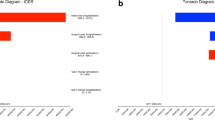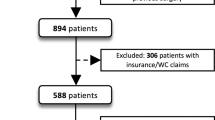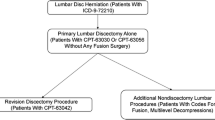Abstract
The cost and utility of surgery for a herniated lumbar disc has not been determined simultaneously in a single cohort. The aim of this study is to perform a cost–utility analysis of surgical and nonsurgical treatment of patients with lumbar disc herniation. Ninety-two individuals in a cohort of 1,146 Swedish subjects underwent lumbar disc herniation surgery during a 2-year study. Each person operated on was individually matched with one treated conservatively. The effects and costs of the treatments were determined individually. By estimating quality of life before and after the treatment, the number of quality adjusted life years (QALY) gained with and without surgery was calculated. The medical costs were much higher for surgical treatment; however, the total costs, including disability costs, were lower among those treated surgically. Surgery meant fewer recurrences and less permanent disability benefits. The gain in QALY was ten times higher among those operated. Lower total costs and better utility resulted in a better cost utility for surgical treatment. Surgery for lumbar disc herniation was cost-effective. The total costs for surgery were lower due to lower recurrence rates and fewer disability benefits, and surgery improved quality of life much more than nonsurgical treatments.
Similar content being viewed by others
References
Andersson GB, Deyo RA (1996) History and physical examination in patients with herniated lumbar discs. Spine 21:10S–18S
Atlas SJ, Keller RB, Chang Y, et al (2001) Surgical and nonsurgical management of sciatica secondary to a lumbar disc herniation: five-year outcomes from the Maine Lumbar Spine Study. Spine 26:1179–1187
Björk S, Norinder A (1999) The weighting exercise for the Swedish version of the EuroQol. Health Econ 8:117–126
Bloch F, Prins R (eds) (2000) Who returns to work and why? A six country study on work incapacity and reintergration. Transaction Publisher, New Brunswick
Brooks R (1996) EuroQol: the current state of play. Health Policy 37:53–72
Burström K (2003) Population health and inequalities in health—measurement of health-related quality of life and changes in QALY over time in Sweden. In: Department of Public Health Sciences, Division of Social Medicine. Karolinska Institutet, Stockholm, Thesis
Drummond M, O’Brien B, Stoddart G et al (1997) Methods for the economic evaluation of health care programmes. Oxford University press, Oxford
Ekman M, Zethraeus N, Dahlström U et al (2002) Kostnadseffektivt att behandla kronisk hjärtsvikt med bisoprolol. Läkartidning 99:646–650
Gibson JN, Grant IC, Waddell G (1999) The Cochrane review of surgery for lumbar disc prolapse and degenerative lumbar spondylosis. Spine 24:1820–1832
Hansson TH, Hansson EK (2000) The effects of common medical interventions on pain, back function, and work resumption in patients with chronic low back pain: a prospective 2-year cohort study in six countries. Spine 25:3055–3064
Hansson EK, Hansson TH (2005) The costs for persons sick-listed more than one month because of low back or neck problems. A two-year prospective study of Swedish patients. Eur Spine J 14:337–345
Henriksson F (2001) Economic aspects of chronic diseases: multiple sclerosis and diabetes mellitus. In: Division of Neurology, Department of Clinical Neuroscience, Occupational Therapy and Elderly Care Research, Karolinska Institutet, Huddinge University Hospital, Stockholm University, Stockholm, Thesis
Jansson KA (2005) On lumbar spinal stenosis and disc herniation surgery. In: Department of Surgical Sciences, Section of Orthopedics. Karolinska Institutet, Stockholm, Thesis
Jansson KA, Nemeth G, Granath F et al (2004) Surgery for herniation of a lumbar disc in Sweden between 1987 and 1999. An analysis of 27,576 operations. J Bone Joint Surg Br 86:841–847
Kohlmann T, Raspe HH (1994) [Grading of backache]. Ther Umsch 51:375–380
Korff von M, Ormel J, Keefe F et al (1992) Grading the severity of chronic pain. Pain 50:133–149
Malter AD, Larson EB, Urban N et al (1996) Cost-effectiveness of lumbar discectomy for the treatment of herniated intervertebral disc (discussion 1055). Spine 21:1048–1054
Rivero-Arias O, Campbell H, Gray A et al (2005) Surgical stabilisation of the spine compared with a programme of intensive rehabilitation for the management of patients with chronic low back pain: cost utility analysis based on a randomised controlled trial. Bmj 330:1239
Torrance GW (1997) Preferences for health outcomes and cost-utility analysis. Am J Manag Care 3(Suppl):S8–S20
Tulder van MW, Koes BW, Bouter LM (1995) A cost-of-illness study of back pain in The Netherlands. Pain 62:233–240
Waddell G (1991) Low back disability. A syndrome of Western civilization. Neurosurg Clin N Am 2:719–738
Weber H (1983) Lumbar disc herniation. A controlled, prospective study with ten years of observation. Spine 8:131–140
Weber H (1994) The natural history of disc herniation and the influence of intervention (discussion 2233). Spine 19:2234–2238
Acknowledgments
We are greatly indebted to Associate Professor Robert Jonsson for statistical advice. This study was supported by grants from the Medical Faculty, Göteborg University and the Swedish Council for Social Research.
Author information
Authors and Affiliations
Corresponding author
Rights and permissions
About this article
Cite this article
Hansson, E., Hansson, T. The cost–utility of lumbar disc herniation surgery. Eur Spine J 16, 329–337 (2007). https://doi.org/10.1007/s00586-006-0131-y
Received:
Accepted:
Published:
Issue Date:
DOI: https://doi.org/10.1007/s00586-006-0131-y




